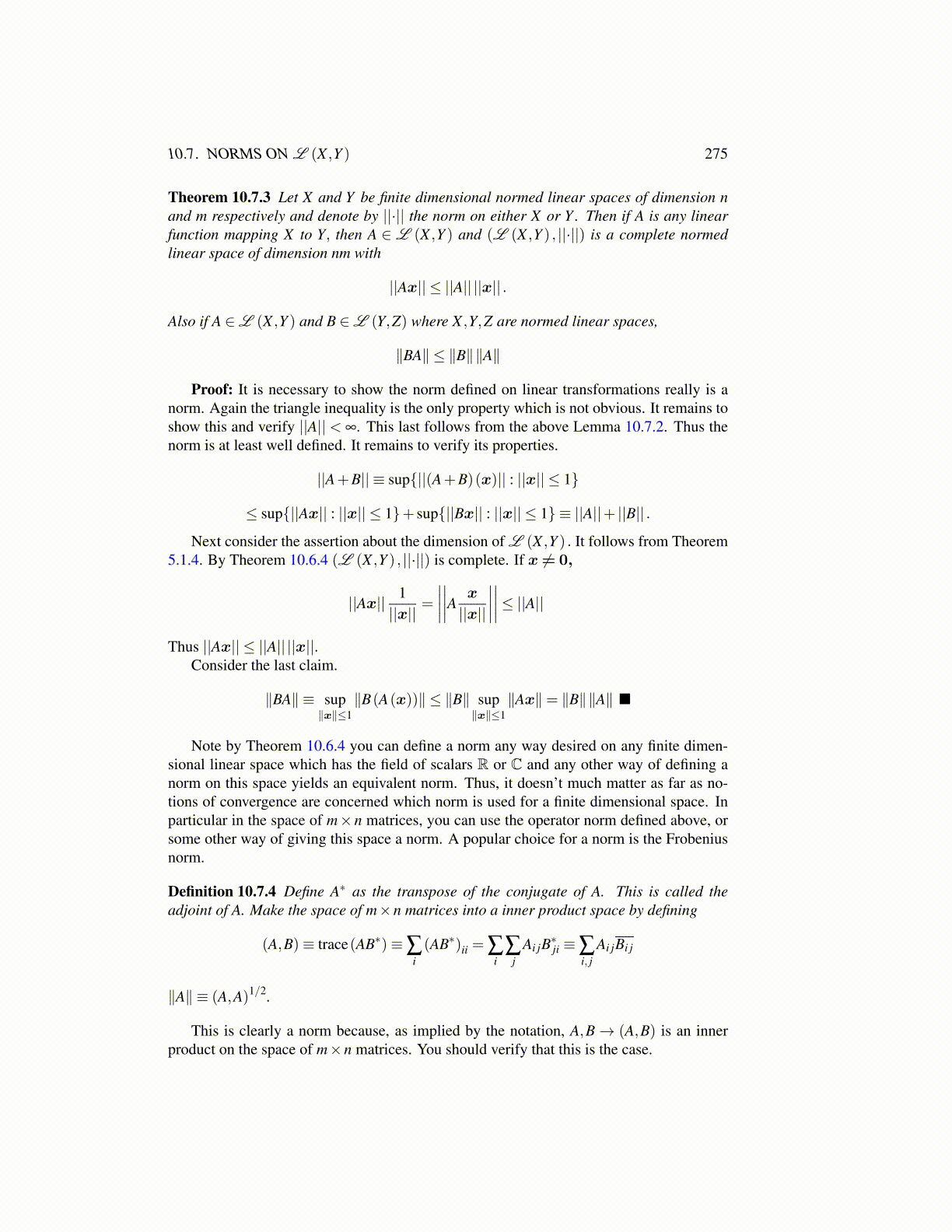
10.7. NORMS ON L (X ,Y ) 275
Theorem 10.7.3 Let X and Y be finite dimensional normed linear spaces of dimension nand m respectively and denote by ||·|| the norm on either X or Y . Then if A is any linearfunction mapping X to Y, then A ∈ L (X ,Y ) and (L (X ,Y ) , ||·||) is a complete normedlinear space of dimension nm with
||Ax|| ≤ ||A|| ||x|| .
Also if A ∈L (X ,Y ) and B ∈L (Y,Z) where X ,Y,Z are normed linear spaces,
∥BA∥ ≤ ∥B∥∥A∥
Proof: It is necessary to show the norm defined on linear transformations really is anorm. Again the triangle inequality is the only property which is not obvious. It remains toshow this and verify ||A|| < ∞. This last follows from the above Lemma 10.7.2. Thus thenorm is at least well defined. It remains to verify its properties.
||A+B|| ≡ sup{||(A+B)(x)|| : ||x|| ≤ 1}
≤ sup{||Ax|| : ||x|| ≤ 1}+ sup{||Bx|| : ||x|| ≤ 1} ≡ ||A||+ ||B|| .
Next consider the assertion about the dimension of L (X ,Y ) . It follows from Theorem5.1.4. By Theorem 10.6.4 (L (X ,Y ) , ||·||) is complete. If x ̸= 0,
||Ax|| 1||x||
=
∣∣∣∣∣∣∣∣A x
||x||
∣∣∣∣∣∣∣∣≤ ||A||Thus ||Ax|| ≤ ||A|| ||x||.
Consider the last claim.
∥BA∥ ≡ sup∥x∥≤1
∥B(A(x))∥ ≤ ∥B∥ sup∥x∥≤1
∥Ax∥= ∥B∥∥A∥ ■
Note by Theorem 10.6.4 you can define a norm any way desired on any finite dimen-sional linear space which has the field of scalars R or C and any other way of defining anorm on this space yields an equivalent norm. Thus, it doesn’t much matter as far as no-tions of convergence are concerned which norm is used for a finite dimensional space. Inparticular in the space of m×n matrices, you can use the operator norm defined above, orsome other way of giving this space a norm. A popular choice for a norm is the Frobeniusnorm.
Definition 10.7.4 Define A∗ as the transpose of the conjugate of A. This is called theadjoint of A. Make the space of m×n matrices into a inner product space by defining
(A,B)≡ trace(AB∗)≡∑i(AB∗)ii = ∑
i∑
jAi jB∗ji ≡∑
i, jAi jBi j
∥A∥ ≡ (A,A)1/2.
This is clearly a norm because, as implied by the notation, A,B→ (A,B) is an innerproduct on the space of m×n matrices. You should verify that this is the case.